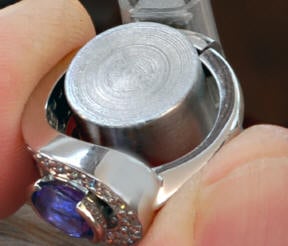950 Palladium Bench Guide
The palladium bench guide reviews the working characteristics of palladium for the jewelry bench staff and provides an overview of the unique advantages and benefits of palladium jewelry for managers, sales professionals and consumers. It is intended to serve as a source for information on the most commonly encountered palladium jewelry scenarios and the related materials available in the industry today.
7 Minute Read
The palladium bench guide reviews the working characteristics of palladium for the jewelry bench staff and provides an overview of the unique advantages and benefits of palladium jewelry for managers, sales professionals and consumers. It is intended to serve as a source for information on the most commonly encountered palladium jewelry scenarios and the related materials available in the industry today.
950 Palladium Alloys
Palladium is alloyed for use in jewelry. Standard alloys contain 950 parts of palladium and 50 parts of other metals (this portion of the alloy may vary among suppliers and origin). The most common alloy component in the U.S. is ruthenium, which, along with palladium belongs to the platinum group of noble metals. Ruthenium usually comprises about 4.8 percent of the 5% mixture, leaving room for trace elements of other metals that improve working, wearing or casting characteristics. The common alloy ingredient used in China, where palladium jewelry is mass produced is 950 parts palladium and the balance copper.
Solder
Palladium or platinum solder is used for soldering 950 palladium alloys. Palladium solder is usually supplied in 'hard', 'medium' and 'easy'. The general flow temperatures for them are:
- Hard - 2,365°F
- Medium - 2,210°F
- Easy - 2,005°F
950 platinum solders are made with gold/silver/palladium or gold/platinum/palladium. More palladium and platinum is present in the higher melting point or "harder" solders. Platinum solders used for soldering palladium are 1,100, 1,200 and 1,300 and they have the same general melt and flow ranges as listed above for palladium solders.
Pre-finishing, Finishing and Polishing
Pre-finishing and polishing requires fewer steps to accomplish as compared to platinum and an extra step or two as compared to white gold. To finish a casting, begin with No. 4 cut files and finish with No. 6 cut or fine abrasive sanding sticks. Grits from 400 to 1,200 are ideal. After using abrasives of 1,200 grit, polish the piece with Bendicks white rouge. For the final step in polishing use a 6,000 grit white rouge. For the best results use files, abrasives and polishing materials dedicated for palladium. Palladium alloys brighten during tumbling and magnetic finishing procedures. Magnetic finishing also restores palladium's polished luster after soldering procedures. No rhodium or other plating is required to improve the color of 950 palladium alloys.
Tools and Equipment
For the best results when working with palladium, use palladium dedicated files, sanding sticks, rotary abrasive materials and polishing wheels. Keep your workbench clean and free of debris from gold and platinum projects. Use high-heat soldering tweezers and pads and always use eye protection.
Palladium Detection
Iodine can be used to detect the difference between palladium, platinum and white gold. To use Iodine, place a drop of it on the cleaned surface of the unknown white metal. As the small drop of Iodine evaporates and dries, it may take on a body color that will assist in the detection of the metal. Here are the most common reactions you can expect with a drop of Iodine after it has dried.
| Alloy | Reaction |
| 950 Palladium | Iodine turns black (as shown in example) |
| 900 and 950 Platinum | Iodine is mostly colorless |
| 14- and 18-karat white gold (below a rhodium plated surface) | Iodine turns brownish |
The above reactions will not occur on a rhodium plated finish. If a rhodium plated surface is present it must be removed at the location where the test drop is placed.
Cost Analysis - Palladium, 14-karat White Gold & Platinum
At the time of this printing, the market prices for metals were:
| Metal | Market Price (per ounce) | Price Per Pennyweight |
| Palladium | $324.00 | $16.20 |
| Platinum | $1,120.00 | $56.00 |
| Gold | $621.00 14-karat - $363.29 18-karat - $465.75 | 14-karat - $18.16 18-karat - $23.28 |
Since metal supplier markups vary, they are not included in this analysis.
Considerations for Palladium
Refining For the best return when refining palladium keep palladium filings, bench sweeps and polishing debris separate from the same containing other precious metals. Also keep palladium hard scrap separate from other precious hard scrap. This will maximize your return and speed the settlement.
You assume all responsibility and risk for the use of the safety resources available on or through this web page. The International Gem Society LLC does not assume any liability for the materials, information and opinions provided on, or available through, this web page. No advice or information provided by this website shall create any warranty. Reliance on such advice, information or the content of this web page is solely at your own risk, including without limitation any safety guidelines, resources or precautions, or any other information related to safety that may be available on or through this web page. The International Gem Society LLC disclaims any liability for injury, death or damages resulting from the use thereof.
The All-In-One Jewelry Making Solution At Your Fingertips
When you join the Ganoksin community, you get the tools you need to take your work to the next level.
Trusted Jewelry Making Information & Techniques
Sign up to receive the latest articles, techniques, and inspirations with our free newsletter.
